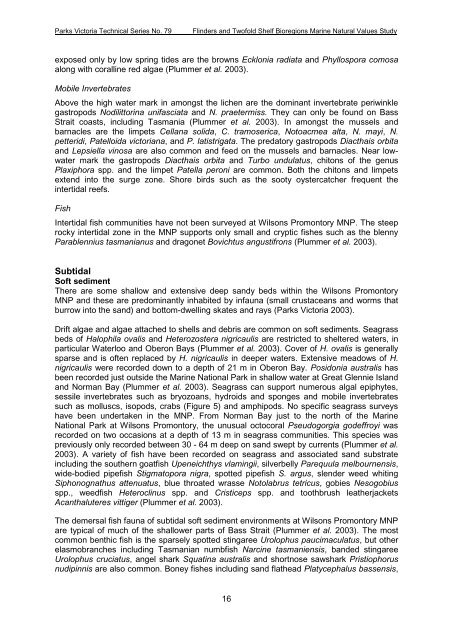parks victoria technical series marine natural values study vol 2 ...
parks victoria technical series marine natural values study vol 2 ...
parks victoria technical series marine natural values study vol 2 ...
Create successful ePaper yourself
Turn your PDF publications into a flip-book with our unique Google optimized e-Paper software.
Parks Victoria Technical Series No. 79<br />
Flinders and Twofold Shelf Bioregions Marine Natural Values Study<br />
exposed only by low spring tides are the browns Ecklonia radiata and Phyllospora comosa<br />
along with coralline red algae (Plummer et al. 2003).<br />
Mobile Invertebrates<br />
Above the high water mark in amongst the lichen are the dominant invertebrate periwinkle<br />
gastropods Nodilittorina unifasciata and N. praetermiss. They can only be found on Bass<br />
Strait coasts, including Tasmania (Plummer et al. 2003). In amongst the mussels and<br />
barnacles are the limpets Cellana solida, C. tramoserica, Notoacmea alta, N. mayi, N.<br />
petteridi, Patelloida <strong>victoria</strong>na, and P. latistrigata. The predatory gastropods Diacthais orbita<br />
and Lepsiella vinosa are also common and feed on the mussels and barnacles. Near lowwater<br />
mark the gastropods Diacthais orbita and Turbo undulatus, chitons of the genus<br />
Plaxiphora spp. and the limpet Patella peroni are common. Both the chitons and limpets<br />
extend into the surge zone. Shore birds such as the sooty oystercatcher frequent the<br />
intertidal reefs.<br />
Fish<br />
Intertidal fish communities have not been surveyed at Wilsons Promontory MNP. The steep<br />
rocky intertidal zone in the MNP supports only small and cryptic fishes such as the blenny<br />
Parablennius tasmanianus and dragonet Bovichtus angustifrons (Plummer et al. 2003).<br />
Subtidal<br />
Soft sediment<br />
There are some shallow and extensive deep sandy beds within the Wilsons Promontory<br />
MNP and these are predominantly inhabited by infauna (small crustaceans and worms that<br />
burrow into the sand) and bottom-dwelling skates and rays (Parks Victoria 2003).<br />
Drift algae and algae attached to shells and debris are common on soft sediments. Seagrass<br />
beds of Halophila ovalis and Heterozostera nigricaulis are restricted to sheltered waters, in<br />
particular Waterloo and Oberon Bays (Plummer et al. 2003). Cover of H. ovalis is generally<br />
sparse and is often replaced by H. nigricaulis in deeper waters. Extensive meadows of H.<br />
nigricaulis were recorded down to a depth of 21 m in Oberon Bay. Posidonia australis has<br />
been recorded just outside the Marine National Park in shallow water at Great Glennie Island<br />
and Norman Bay (Plummer et al. 2003). Seagrass can support numerous algal epiphytes,<br />
sessile invertebrates such as bryozoans, hydroids and sponges and mobile invertebrates<br />
such as molluscs, isopods, crabs (Figure 5) and amphipods. No specific seagrass surveys<br />
have been undertaken in the MNP. From Norman Bay just to the north of the Marine<br />
National Park at Wilsons Promontory, the unusual octocoral Pseudogorgia godeffroyi was<br />
recorded on two occasions at a depth of 13 m in seagrass communities. This species was<br />
previously only recorded between 30 - 64 m deep on sand swept by currents (Plummer et al.<br />
2003). A variety of fish have been recorded on seagrass and associated sand substrate<br />
including the southern goatfish Upeneichthys vlamingii, silverbelly Parequula melbournensis,<br />
wide-bodied pipefish Stigmatopora nigra, spotted pipefish S. argus, slender weed whiting<br />
Siphonognathus attenuatus, blue throated wrasse Notolabrus tetricus, gobies Nesogobius<br />
spp., weedfish Heteroclinus spp. and Cristiceps spp. and toothbrush leatherjackets<br />
Acanthaluteres vittiger (Plummer et al. 2003).<br />
The demersal fish fauna of subtidal soft sediment environments at Wilsons Promontory MNP<br />
are typical of much of the shallower parts of Bass Strait (Plummer et al. 2003). The most<br />
common benthic fish is the sparsely spotted stingaree Urolophus paucimaculatus, but other<br />
elasmobranches including Tasmanian numbfish Narcine tasmaniensis, banded stingaree<br />
Urolophus cruciatus, angel shark Squatina australis and shortnose sawshark Pristiophorus<br />
nudipinnis are also common. Boney fishes including sand flathead Platycephalus bassensis,<br />
16

















